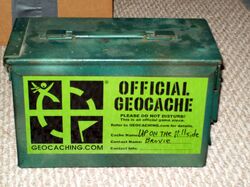- For the Geocaching.com website, see Geocaching.com.
| Geocaching | |
|---|---|
 The Geocaching Logo [copy 1] | |
|
What is it? |
A treasure hunt using GPS. |
|
What do you do? |
Find containers with objects inside. |
Geocaching is a special treasure hunt for finding objects called "geocaches", which can be anything from a small metal tube to tupperware to ammunition cans. To join the hunt, you must have a GPS-enabled device and a free membership at Geocaching.com.
How to find Geocaches
To find a geocache, visit the Geocaching website. Sign up for a free account, selecting a desired handle(user name). On the main page, enter a desired location, either using an address, town, zip code, or your latitude and longitude. Pick one of the caches from the search results to visit the geocache page. Read the geocache description page and enter the geocache coordinates into your GPS. Then you go to those coordinates and look for the hidden geocache (sometimes there are hints that may help). When you find the geocache, write your geocaching name, the date, and any comments in the logbook or logsheet inside (depending on available space). Rehide the geocache exactly as you found it. Once at home, log into the Geocaching site and go back to that geocache page. Click on "Log your visit" in the upper right. Select the appropriate options for the type of log and date, then type in a message. Once you are finished, click on "Submit" at the bottom of the page.
Congratulations. You just found your first geocache.

Geocaching Basics
A new video from Geocaching on YouTube.
Geocache types
There are a variety of different types of geocaches. The most common is a traditional cache. Other types include multicache, events, and mystery cache. For more cache types, see this page.
Objects inside geocaches

A regular-sized cache consisting of an ammo can.
Sometimes, you will find geocaches with more than just a logsheet inside. Larger geocaches can contain many things. Some objects are called "swag". Anyone can trade for these objects and there is no obligation to put them into another geocache. The general rule of thumb is if you take something out, then put something back in to replace it (that someone else might want). Toys, signature items (such as wooden nickels and other craft items), pins, etc., are all common forms of swag.
Another type of object is called a trackable. Trackables come in two forms: Travel Bugs and Geocoins. These items actually belong to someone and are designed to move from cache to cache. Many owners of trackables will assign missions for them to complete. They are not meant to be kept.
Sometimes, you will find a small, nickel-sized coin called a Pathtag. These are relatively inexpensive, personalized tags that you are welcome to keep if you find them. Many geocachers will collect them.
Cache In Trash Out
- Main article: Cache In Trash Out
The C.I.T.O. Program is dedicated to helping take trash out of caching areas. This program is usually implemented during special C.I.T.O. events, though it is encouraged as a normal, everyday geocaching practice.
Membership
There are two types of membership: basic and premium. Basic membership is free and premium membership costs $30 USD a year, or $10 USD for 3 months.
Membership benefits
| Benefit | Basic Membership | Premium Membership |
|---|---|---|
| Rate Your Favorites | No | Yes |
| Statistics | No | Yes |
| Maps | Yes | Yes |
| Create And Share Geocaching Lists | No | Yes |
| Custom Searches | No | Yes |
| Be Instantly Notified of Geocaches | No | Yes |
| Caches Along a Route | No | Yes |
| Support Geocaching.com | No | Yes |
| Premium Member Access to all Groundspeak Websites | No | Yes |
| Access to Location | Yes | Yes |
| Share Your Experiences | Yes | Yes |
References
Copyrights
- ^ The Groundspeak Geocaching Logo is a registered trademark of Groundspeak, Inc. Used with permission.
- ^ Copyright © 2000-2012 Groundspeak Inc. All Rights Reserved.